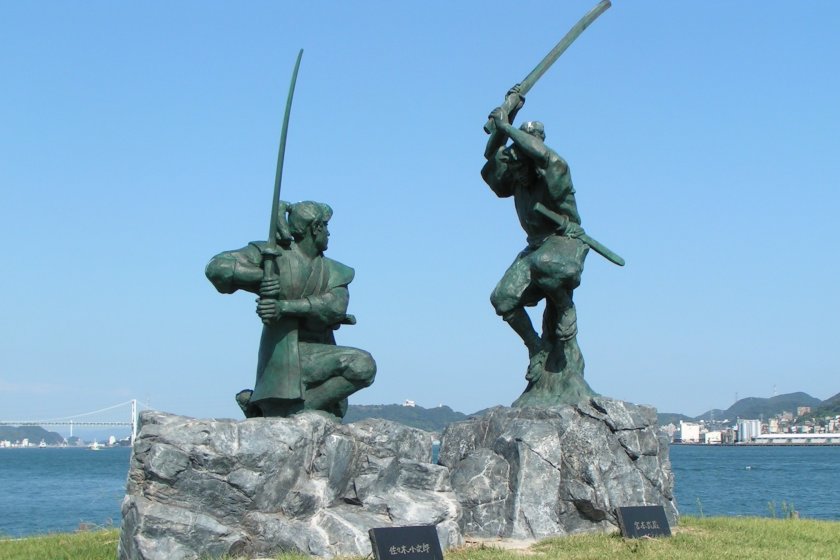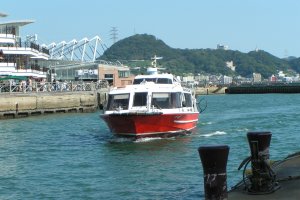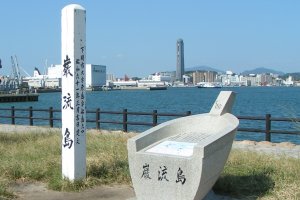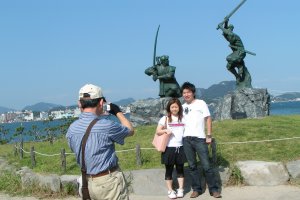The Kanmon Straits, aka the straits of Shimonoseki, separates Yamaguchi prefecture on the western edge of Honshu and Fukuoka prefecture on Kyushu island. About 6,000 years ago a crustal change divided Honshu in two, and the straits and Kyushu island were born. To some tourists it may just look like ordinary straits, but in fact this is the place where some great historical sea battles were fought, which makes it significantly dramatic and not just an ordinary expanse of sea water.
The Battle of Dan-no-ura (1185)
These straits first played a dramatic role in 'The Battle of Dan-no-ura' in 1185. The first full-scale sea battle in Japan’s history was fought here, occurring at the end of the Genpei War. It happened when Samurai were slowly gaining political power in Japan, and Genji (Minamoto Clan) and Heishi (Taira Clan) were struggling for power. Minamotono Yoritomo, who was the head of Genji and won this battle, later founded the first feudal military government in Japan, the Kamakura Shogunate in 1192.
The ships used in this battle were of course rowing boats, and 800 to 3,000 wooden rowing boats of Genji fought against 500 to 1,000 boats of Heishi. If you have ever visited these straits, you'll know how rough the current is, which makes me wonder how in the world they managed to fight in these extremely rough currents in wooden rowing boats....They must have been desperate!
In the end, Heishi was defeated by the Genji military force which was led by Minamoto-no Yoshitsune, and sunk to the bottom of the sea, all together, young and old, women and men. There's a proverb in Japan describing the rise and fall of Heishi, 'The proud Heike (Heishi) will have a fall', but I believe I'm not the only one who can't help feeling sorry for them.
The duel on Ganryu-jima (AD1612)
Ganryu jima is a small island located in the middle of these straits. Here, the duel between two famous swordsmen, Miyamoto Musashi and Sasaki Kojiro took place. They also went to the island by wooden rowing boats. I've visited the island by speed boat, but my boat swayed terribly throughout the ride due to the rough current. I was more intrigued by why on earth they wanted to come all the way to this island by wooden boats than the duel itself. As you might know, the duel ended with Musashi killing Kojiro. To get to the island you can take a speed boat either from the port of Shimonoseki or Moji on the Kyushu side. The round trip fee is 800 yen for adults, 400 for children. It only takes a few minutes to reach the island. There are other attractions such as Kanmon Straits pleasure cruises (40 min).
On the island, you'll have a panoramic view of the Kanmon straits and the surrounding areas without anything blocking your view. As there are no high piers, you can see large vessels up close. When I was there, there was something black moving along the surface of the sea. As soon as the question formed in my head, 'What's that?' a submarine of Japan Defense Force materialized from the sea, which of course excited me a lot, for I'd never seen submarines coming out of sea in my life! If you happen to be near Shimonoseki or Fukuoka, jump onto the speed boat and visit this island. Even if you are not interested in duels or swordsmen, I'm sure you'll have a great opportunity to see large vessels and battleships of the Japan Defense Force up close.
Shimonoseki Campaign (1863 & 1864)
At the end of the Edo Era, The Choshu Clan (of present day Yamaguchi prefecture) fired cannon after cannon toward steam warships and merchant steamers of the U.S.A, France, England and The Netherlands, screaming "Expel the barbarians!” Of course, retaliation against them was swift and severe, and they lost the battle. The Choshu Clan learned their lesson and realized the futility of fighting against western powers with poor, outdated military armament. Because of lessons learned from this war, Japan later changed their policy from closing the country to opening the country to the world. Drop by to see the cannons that were fired in this war now displayed near the port of Shimonoseki.
Besides these, the Kanmon Straits left quite a few other footprints in the history of Japan, but as far as battles and wars are concerned, these three battles are the most prominent. This strait itself IS one of the biggest historical spots in Japan. Although many people usually take planes or the Shinkansen to visit Kyushu and don’t waste even a glance at these straits, if you ever come near Yamaguchi or Kyushu, it might be a good idea to stop by this Kanmon Straits, take a moment to look back on its history, and think about the people who selflessly risked and gave their lives for what they believed in.


































